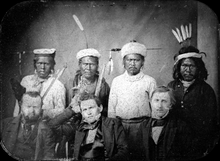
The Pomo are a Native American people of California. Historical Pomo territory in Northern California was large, bordered by the Pacific Coast to the west, extending inland to Clear Lake, and mainly between Cleone and Duncans Point. One small group, the Tceefoka, lived in the vicinity of present-day Stonyford in Colusa County, separated from the core Pomo area by lands inhabited by Yuki and Wintuan speakers.
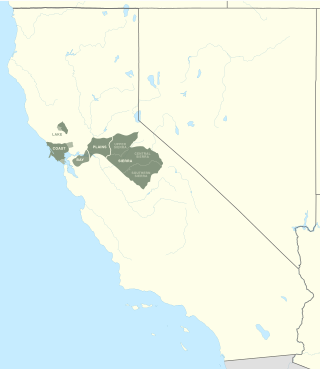
The Miwok are members of four linguistically related Native American groups indigenous to what is now Northern California, who traditionally spoke one of the Miwok languages in the Utian family. The word Miwok means people in the Miwok languages.

The Coast Miwok are an Indigenous people of California that were the second-largest tribe of the Miwok people. Coast Miwok inhabited the general area of modern Marin County and southern Sonoma County in Northern California, from the Golden Gate north to Duncans Point and eastward to Sonoma Creek. Coast Miwok included the Bodega Bay Miwok, or Olamentko (Olamentke), from authenticated Miwok villages around Bodega Bay, the Marin Miwok, or Hookooeko (Huukuiko), and Southern Sonoma Miwok, or Lekahtewutko (Lekatuit). While they did not have an overarching name for themselves, the Coast Miwok word for people, Micha-ko, was suggested by A. L. Kroeber as a possible endonym, keeping with a common practice among tribal groups and the ethnographers studying them in the early 20th Century and with the term Miwok itself, which is the Central Sierra Miwok word for people.

Achomawi are the northerly nine bands of the Pit River tribe of Palaihnihan Native Americans who live in what is now northeastern California in the United States. These 5 autonomous bands of the Pit River Indians historically spoke slightly different dialects of one common language, and the other two bands spoke dialects of a related language, called Atsugewi. The name "Achomawi" means river people and properly applies to the band which historically inhabited the Fall River Valley and the Pit River from the south end of Big Valley Mountains, westerly to Pit River Falls. The nine bands of Achumawi lived on both sides of the Pit River from its origin at Goose Lake to Montgomery Creek, and the two bands of Atsugewi lived south of the Pit River on creeks tributary to it in the Hat Creek valley and Dixie Valley.
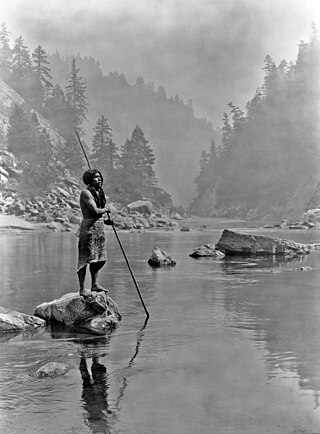
Hupa are a Native American people of the Athabaskan-speaking ethnolinguistic group in northwestern California. Their endonym is Natinixwe, also spelled Natinook-wa, meaning "People of the Place Where the Trails Return". The Karuk name was Kishákeevar / Kishakeevra. The majority of the tribe is enrolled in the federally recognized Hoopa Valley Tribe.

Indian Grinding Rock State Historic Park is a California State Park, preserving an outcropping of marbleized limestone with some 1,185 mortar holes—the largest collection of bedrock mortars in North America. It is located in the Sierra Nevada foothills, 8 miles (13 km) east of Jackson. The park is nestled in a little valley 2,400 feet (732 m) above sea level, with open meadows and large specimens of valley oak that once provided the Miwok peoples of this area with an ample supply of acorns. The 135-acre (55 ha) park was established in 1962 and listed on the National Register of Historic Places in 1971.

The Yokuts are an ethnic group of Native Americans native to central California. Before European contact, the Yokuts consisted of up to 60 tribes speaking several related languages. Yokuts is both plural and singular; Yokut, while common, is erroneous. 'Yokut' should only be used when referring specifically to the Tachi Yokut Tribe of Lemoore. Some of their descendants prefer to refer to themselves by their respective tribal names; they reject the term Yokuts, saying that it is an exonym invented by English-speaking settlers and historians. Conventional sub-groupings include the Foothill Yokuts, Northern Valley Yokuts, and Southern Valley Yokuts.

The Patwin are a band of Wintun people in Northern California. The Patwin comprise the southern branch of the Wintun group, native inhabitants of California since approximately 500.

Maiduan is a small endangered language family of northeastern California.
The Konkow language, also known as Northwest Maidu is a part of the Maiduan language group. It is spoken in California. It is severely endangered, with three remaining elders who learned to speak it as a first language, one of whom is deaf. As part of an effort to regain official recognition as a federally recognized tribe, an effort to provide language instruction amongst the descendants of the original tribe and affiliated family members has begun.

The Nisenan are a group of Native Americans and an Indigenous people of California from the Yuba River and American River watersheds in Northern California and the California Central Valley. The Nisenan people are classified as part of the larger group of Native Americans known as the Maidu, though some dispute the accuracy of this relationship. They have been delineated by their geographical location, and so in many texts they are further subcategorized as the Valley Nisenan, Hill Nisenan, and Mountain Nisenan.
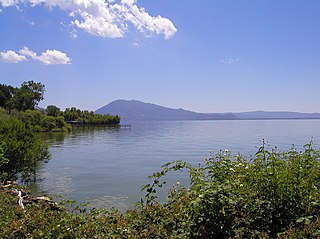
The Lake Miwok are a branch of the Miwok, a Native American people of Northern California. The Lake Miwok lived in the Clear Lake basin of what is now called Lake County. While they did not have an overarching name for themselves, the Lake Miwok word for people, Hotsa-ho, was suggested by A. L. Kroeber as a possible endonym, keeping with a common practice among tribal groups and the ethnographers studying them in the early 20th Century and with the term Miwok itself, which is the Central Sierra Miwok word for people.

The Plains and Sierra Miwok were once the largest group of California Indian Miwok people, Indigenous to California. Their homeland included regions of the Sacramento Valley, San Joaquin Valley, and the Sierra Nevada.

Kuksu was a religion in Northern California practiced by members within several Indigenous peoples of California before and during contact with the arriving European settlers. The religious belief system was held by several tribes in Central California and Northern California, from the Sacramento Valley west to the Pacific Ocean.
Maidu traditional narratives include myths, legends, tales, and oral histories preserved by the Maidu, Konkow, and Nisenan people of eastern Sacramento Valley and foothills in northeastern California.
The Berry Creek Rancheria of Maidu Indians of California are a Native American people based in northeastern California, south of Lassen Peak. They historical have spoken the Konkow language, also known as Northeastern Maidu.

The Mooretown Rancheria of Maidu Indians of California is a federally recognized tribe of Concow and Maidu people in Butte County. Concow, or Konkow, people are the northwestern or foothill branch of the Maidu people, who traditionally spoke the Concow language
The California Rancheria Termination Acts refer to three acts of Congress and an amendment passed in the 1950s and 1960s as part of the US Indian termination policy. The three Acts, passed in 1956, 1957, and 1958 targeted 41 Rancherias for termination. An additional seven were added via an amendment in 1964. Including three previous terminations, 46 of the 51 targeted Rancherias were successfully terminated. Through litigation and legislation, over 30 Rancherias have been restored and at least five are still working to be.
The Nevada City Rancheria was the federally recognized land and name of the Nisenan Native American people in Northern California. The Rancheria land was obtained in 1887 by Tribal Chief Charley Cully. When he died in 1911, the land allotment was converted by an executive order of President Woodrow Wilson into the Nevada City Rancheria.
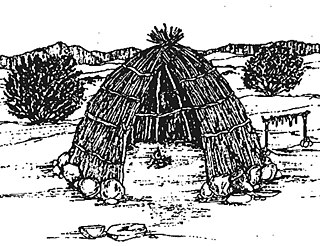
Nisipowinan Village, also spelled Nisenan Village was a major Nisenan Native American tribe Village that is a historical site in Sacramento, California. The Nisipowinan Village in Sacramento is a California Historical Landmark No. 900 listed on June 16, 1976. The Sacramento Nisipowinan Village was located on the north banks of the American River just east of the now Interstate 5 Freeway in the Sacramento Discovery Park. The Nisenan tribe was part of the Maidu tribe. I the 1840s Nisenan tribe traded and worked in peace with people in and around Sutter's Fort, founded by John Sutter in 1839, was located on the south bank of the American River.


